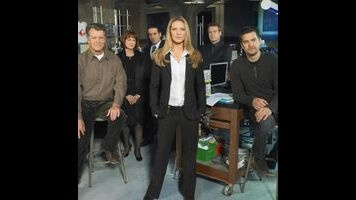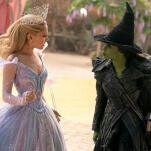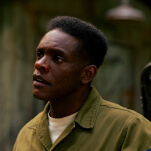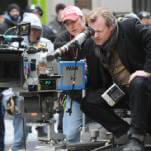I bring this up here only because as much as I enjoyed “Transilience Thought Unifier Model-11,” for about the first two-thirds of the episode I found myself thinking, “This is a lot of fun, but what’s the reason for all this? What lingering questions about Fringe is this season going to answer?” I mean, sure, The Observers, and the grim future, and the fate of the Bishop family and all that; but that’s all plot, and Fringe has always been about more than just what happens to the characters. That’s why I found last season’s finale mildly disappointing. I don’t need Peter and Olivia and Walter to live happily ever after; I need Fringe to grapple honestly with the questions it’s raised over the years, about how the multitude of possibilities inherent in scientific discovery can transform the nature of who we are, and lead us to make choices we probably shouldn’t. And that didn’t appear to be the direction “Transilience Thought Unifier Model-11” was headed in its first half-hour. Once Peter’s reunited with Olivia about halfway through the episode, it’s not too hard to imagine the rest of this season as an exciting but ultimately weightless sci-fi/action epic, culminating in another triumph for our heroes.
And then they fried Walter’s brain. Again.
On a practical level, the Walter-frying serves a couple of functions. The first, and perhaps most important, is that frazzled Walter is the Walter we’ve spent the last four years with, more or less, and as we’re moving toward the series’ ultimate conclusion, it helps to anchor the story with someone we already know and care about—not the more confident, brusque Walter we saw at the end of “Letters Of Transit,” and at the start of this episode. (Some former Fringe fans have argued that this was the problem with last season, that the characters were essentially new people after the timeline-readjustment, but for me the differences were so minor and so thematically appropriate that they didn’t bother me. But we’ve been over that before. Too many times, probably.)
Walter’s brain damage also complicates the plot in compelling ways. “Transilience Thought Unifier Model-11” opens not too long after the events of “Letters Of Transit,” in the Observer-controlled dystopia of 2036, with the newly revived Walter, Peter, and Astrid working with Fringe agent and undercover resistance fighter Henrietta Bishop to track down the long-missing Olivia Dunham, who may be dead or “amber”ed, but who either way could be in possession of a piece of Observer-besting technology that September and Walter left with her. Through a series of intense flashbacks, we get glimpses of what happened to our Fringe folk after their abundance of happy endings in “Brave New World.” Etta was born, and grew up with her loving parents for a few years, until The Observers arrived suddenly and en masse, separating the family in the melee. Olivia ultimately joined Walter in the fight against The Observers, while Peter searched for Etta—causing no small measure of hard feelings—until they all, on their own, retreated into amber to await a more opportune time to strike.
Etta found Walter and Peter (the latter of whom was frozen alongside Astrid and the un-revived William Bell) in “Letters Of Transit.” So in “Transilience Thought Unifier Model-11,” the Bishops navigate the “miserable future”—where humans consume a foodstuff called “egg sticks,” and The Observers purposefully poison the air with carbon monoxide so that they can breathe better—until they find a band of “amber gypsies,” who tell them that Olivia’s ambered body was sold to their old arcane bookseller pal Edward Markham, who’s turned her into a coffee table/imaginary friend. The revived Olivia does in fact have September’s device, which we’re told is a “thought unifier,” designed to reassemble plans and ideas that have been intentionally fragmented in the user’s minds, to avoid detection by the mind-reading Observers. But the device is useless, because during an interrogation by a particularly vicious Observer (whom we saw last in “Letters Of Transit”), Walter’s mind gets scrambled, and he loses the thoughts that the machine was meant to unify.
The Walter-torture is one of the most excruciating scenes in Fringe history, made all the more powerful by the abrasive soundtrack, and by the fact that it’s all taking place inside Walter’s head, which means we’re left to imagine how bad it must actually be for him. But the pain makes the ultimate outcome more meaningful, as it restores the character’s pathos.
I’m going to be honest: I’m not the biggest fan of grades for serialized shows in the first place, and it’s going to be especially difficult to assess this season of Fringe from week to week, since it appears the writers are going to drop the case-of-the-week format and just tell one long story, unlike any they’ve done before. It might take a while to adjust to this, and it could be that some elements that seem to be working are just dead-ends, and vice-versa. We’re all in this together, Fringe fans, watching to see how these last 13 episodes play out. So don’t get too hung up on the grades, is what I’m saying. (Actually, that’s good advice for every TV Club review.)
I will say though that I thought “Transilience Thought Unifier Model-11” was a solid “B” episode at the start—interesting world and story, not much depth—and then it bumped up to a “B+” once Olivia arrived, and the emotion started to creep in. I’m glad that credited writer J.H. Wyman (now the show’s sole showrunner after the departure of Jeff Pinkner) took the time amid all the tense skulking around Observer-controlled streets to let the characters talk to each other about their memories and regrets. Fringe can be heavy-handed about its sentiment sometimes, but Olivia wryly saying, “We didn’t save the world?” and Peter quietly answering, “Not even by half,” provided a strong baseline of feeling for the episode to work off of. I was also heartened by the very Fringe-y way that Peter and Olivia sneak into a Fringe Division facility to free Walter: They use tech that makes them appear to be dead. (And as we well know, on Fringe, death is not the end.)
But the episode—and perhaps the season—finds its meaning in its closing scenes, after Peter and Olivia spring Walter, bring him home, and discover that he’s addlepated again. Then a frustrated, depressed Walter sees the reflection of a sculpture made out of broken and discarded CDs, and since he’s been missing music in 2036, he wanders into the street, where he finds a car with a mix CD. He pops the disc in, listens to Yazoo’s “Only You,” and then sees a flower growing up through the rubble.
So here we are, in a future where human lifespan will soon be reduced to around 45 by the poisoned air, and where, according to The Observers’ chief enforcer, “nothing grows from scorched earth.” But at the beginning of “Transilience Thought Unifier Model-11,” we saw Etta blowing on a dandelion, with each seed representing a potential new dandelion, containing commonalities with its parent and yet still an organism all its own. All it takes is one seed. And as we’ve learned on Fringe over the past four years, Walter Bishop is a man with a pocketful.
Stray observations:
- I can’t read “Transilience Thought Unifier Model-11” without wanting to add the words “with announcements.”
- So we’re back to the “Letters Of Transit” credits for the duration, huh? I wonder if we’ll get any extended flashback episodes this season, with the old Fringe credits, just for nostalgia’s sake?
- This episode had two directors: Miguel Sapochnik and Jeannot Szwarc. Not sure why that would be, unless they had to do re-shoots (possible, given John Noble’s recent health issues), or unless one of them worked only on the flashbacks.
- You might be living in a dystopia when… the authorities say things like, “Resistance is futile!”
- Welcome to 2036! There are robo-geishas here, and a handful of walnuts is worth about $3,000, but the future versions of Words With Friends don’t recognize the word “naugahyde,” even though it was once a very popular premium pleather.
- Even in the future, people enjoy watching Clint Eastwood grumble at stuff. (That was “Duel At Sundown,” by the way, a very good second season Maverick episode. I often think of Bret Maverick as “Mr. Maver-ack” because of Eastwood.)
- How bad do you think Olivia’s breath would smell after being trapped in amber for 20 years?
- Markham, trying to create his own legend: “He died a hero’s death. People were sad.”
- It’s always the red wire… unless it’s the white wire.
- One way to tell Walter’s not right in the head: He walks outside without pants.
- Hanging from the rearview mirror of Walter’s favorite Yazoo-listening car: a seahorse.







































